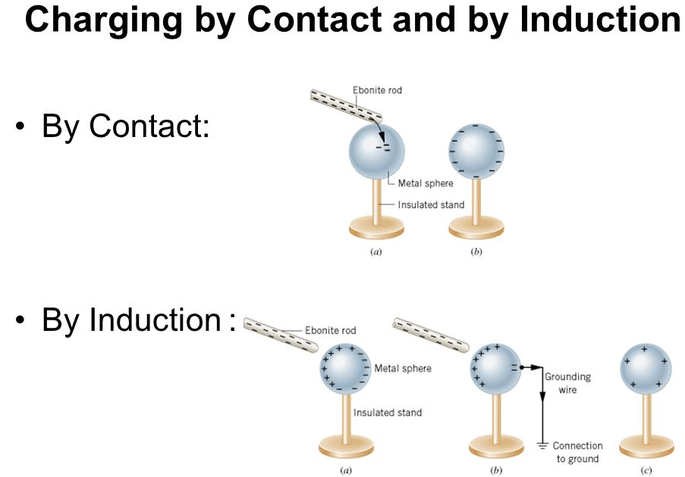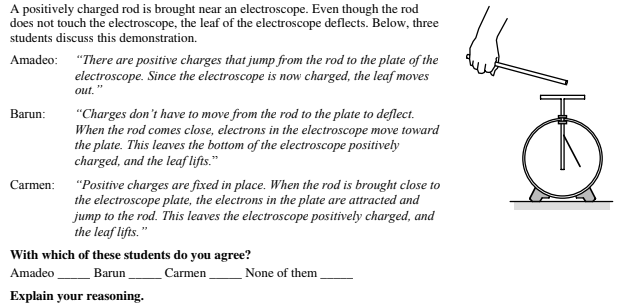3.4 Charge Distribution— Friction, Conduction, and Induction
5 min read•june 18, 2024
K
Krish Gupta
Daniella Garcia-Loos
AP Physics 2 🧲
61 resourcesSee Units
How an Object Becomes Charged
There are 3 main ways to cause an object to become charged:
Friction: Rubbing two objects together can cause one object to lose electrons and the other to gain them. The object that loses electrons becomes positively charged, and the object that gains electrons becomes negatively charged.
Contact: A charged object is touched to a neutral object. The neutral object gains the same charge as the initially charged object.
Induction: A charged object is brought near, but does not touch, a neutral object. The neutral object becomes polarized. In this process, the opposite charge is attracted to the rod and moves closer, while the similar charge is repelled and moves farther away. If the neutral object is grounded, the similar charge will leave the sphere, which results in the sphere becoming oppositely charged in comparison to the original charged object.

Image from weebly.com
Charging by contact and charging by induction are two methods by which objects can become charged electrically. Here are some key points about charging by contact and charging by induction:
- Charging by contact: Charging by contact occurs when two objects come into contact with each other and one of the objects transfers some of its electric charge to the other object. This can happen when two objects are rubbed together, for example.
- Charging by induction: Charging by induction occurs when an object becomes charged electrically without physically touching another charged object. This can happen when an object is placed near a charged object, and the electric field of the charged object causes the electrons in the uncharged object to rearrange themselves.
- Examples of charging by contact: Charging by contact can be observed in everyday phenomena such as static electricity, which occurs when two objects are rubbed together and one of the objects becomes charged.
- Examples of charging by induction: Charging by induction can be observed in phenomena such as lightning, which occurs when an electric charge is transferred from a cloud to the ground.
| Charging Method | Initial Charge on Objects | Contact? | Charge Movement | Final Charge |
| Friction/Rubbing | Both are neutral | Yes. (as contact increases, more charge is transferred) | Electrons move from the object with weaker hold, to the object with stronger hold | Two oppositely charged objects (one is +, the other is -) |
| Contact | One is neutral, one is charged | Brief contact | Electrons move between the objects until the charge is balanced on each | Both have the same charge |
| Induction (Temporary) | One is neutral, one is charged | None | No grounding wire, like charges move away from the charged object, opposite charges move towards the object. Nothing leaves the neutral object | Once the charged object leaves, the neutral object is still neutral |
| Induction (Permanent) | One is neutral, one is charged | None | With grounding wire, like charges leave the neutral object | Once the charged object leaves, the neutral object is charged opposite to the original charged object |
Practice Question:
1.

Image created by the author
Answer:
- Barun is correct. This is charging by induction. The positive rod coming close to the electroscope will cause the positive charge in the electroscope to be repelled, traveling down to the leaves which makes the leaves separate.
Example Question 1:
A positive charge is placed at the center of a uniformly charged ring. How will the charges on the ring be distributed?
Solution:
When a positive charge is placed at the center of a uniformly charged ring, the charges on the ring will be distributed such that the charges on the inner portion of the ring are attracted towards the positive charge, while the charges on the outer portion of the ring are repelled away from the positive charge.
This can be demonstrated using Coulomb's Law, which states that the force between two charges is directly proportional to the product of the charges and inversely proportional to the square of the distance between the charges.
In this case, the positive charge at the center of the ring will attract the negative charges on the inner portion of the ring, while repelling the positive charges on the outer portion of the ring. As a result, the charges on the ring will be distributed such that the charges on the inner portion of the ring are attracted towards the positive charge, while the charges on the outer portion of the ring are repelled away from the positive charge.
Example Question 2:
A positive charge is placed at one end of a uniformly charged rod. How will the charges on the rod be distributed?
Solution:
When a positive charge is placed at one end of a uniformly charged rod, the charges on the rod will be distributed such that the charges on the end of the rod closest to the positive charge are attracted towards the positive charge, while the charges on the end of the rod farthest from the positive charge are repelled away from the positive charge.
This can be demonstrated using Coulomb's Law, which states that the force between two charges is directly proportional to the product of the charges and inversely proportional to the square of the distance between the charges.
In this case, the positive charge at one end of the rod will attract the negative charges on the end of the rod closest to the positive charge, while repelling the positive charges on the end of the rod farthest from the positive charge. As a result, the charges on the rod will be distributed such that the charges on the end of the rod closest to the positive charge are attracted towards the positive charge, while the charges on the end of the rod farthest from the positive charge are repelled away from the positive charge.
Example Question 3:
A positive charge is placed at the center of a uniformly charged sphere. How will the charges on the sphere be distributed?
Solution:
When a positive charge is placed at the center of a uniformly charged sphere, the charges on the sphere will be distributed such that the charges on the inner portion of the sphere are attracted towards the positive charge, while the charges on the outer portion of the sphere are repelled away from the positive charge.
This can be demonstrated using Coulomb's Law, which states that the force between two charges is directly proportional to the product of the charges and inversely proportional to the square of the distance between the charges. In this case, the positive charge at the center of the sphere will attract the negative charges on the inner portion of the sphere, while repelling the positive charges on the outer portion of the sphere.
Browse Study Guides By Unit
💧Unit 1 – Fluids
🔥Unit 2 – Thermodynamics
⚡️Unit 3 – Electric Force, Field, & Potential
💡Unit 4 – Electric Circuits
🧲Unit 5 – Magnetism & Electromagnetic Induction
🔍Unit 6 – Geometric & Physical Optics
⚛️Unit 7 – Quantum, Atomic, & Nuclear Physics
📆Big Reviews: Finals & Exam Prep
📚Study Tools

Fiveable
Resources
© 2025 Fiveable Inc. All rights reserved.